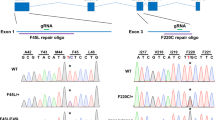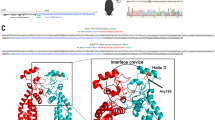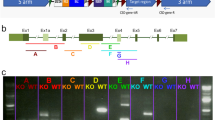Abstract
Retinitis pigmentosa (RP) represents the most common mendelian degenerative retinopathy of man, involving death of rod photoreceptors, cone cell degeneration, retinal vessel attenuation and pigmentary deposits1,2. The patient experiences night blindness, usually followed by progressive loss of visual field. Genetic linkage between an autosomal dominant RP locus and rhodopsin3, the photoreactive pigment of the rod cells, led to the identification of mutations within the rhodopsin gene in both dominant and recessive forms of RP3–7. To better understand the functional and structural role of rhodopsin in the normal retina and in the pathogenesis of retinal disease, we generated mice carrying a targeted disruption of the rhodopsin gene. Rho−/− mice do not elaborate rod outer segments, losing their photoreceptors over 3 months. There is no rod ERG response in 8-week-old animals. Rho+/− animals retain the majority of their photoreceptors although the inner and outer segments of these cells display some structural disorganization, the outer segments becoming shorter in older mice. These animals should provide a useful genetic background on which to express other mutant opsin transgenes, as well as a model to assess the therapeutic potential of re-introducing functional rhodopsin genes into degenerating retinal tissues.
This is a preview of subscription content, access via your institution
Access options
Subscribe to this journal
Receive 12 print issues and online access
$209.00 per year
only $17.42 per issue
Buy this article
- Purchase on Springer Link
- Instant access to full article PDF
Prices may be subject to local taxes which are calculated during checkout
Similar content being viewed by others
References
Heckenlively, J.R. Retinitis Pigmentosa. 125–149 (J.B. Lippincott, Philadelphia, 1988).
Pagon, R.A. Retinitis pigmentosa. Surv. Ophthalmol. 33, 137–177 (1988).
McWilliam, P. et al. Autosomal dominant retinitis pigmentosa: localization of an adRP gene to the long arm of chromosome 3. Genomics 5, 619–622 (1989).
Dryja, T.D. et al. A point mutation of the rhodopsin gene in one form of retinitis pigmentosa. Nature 343, 364–366 (1990).
Humphries, P., Kenna, P. & Farrar, G.J. On the molecular genetics of retinitis pigmentosa. Science, 256, 804–808 (1992).
McLaughlin, M.E., Sandberg, M.A., Berson, E.L. & Dryja, T.P. Recessive mutations in the gene encoding the beta-subunit of rod phosphodiesterase in patients with retinitis pigmentosa. Nature Genet. 4, 130–133 (1993).
Dryja, T.P., Finn, J.T., Peng, Y.-W., McGee, T.L. & Berson, E.L. Mutations in the gene encoding the alpha-subunit of the rod cGMP-gated channel in autosomal recessive retinitis pigmentosa. Proc. Natl. Acad. Sci. USA 92, 10177–10181 (1995).
Carter-Dawson, L.D. & LaVail, M.M. Rods and cones in the mouse retina I. Structural analysis using light and electron microscopy. J. Comp. Neurol. 188, 245–262 (1979).
Hicks, D. & Molday, R.S. Differential immunogold-dextran labeling of bovine and frog rod and cone cells using monoclonal antibodies against bovine rhodopsin. Exp. Eye Res. 42, 55–71 (1986).
Brown, K.T. The electroretinogram: Its components and their origins. Vision Res. 8, 633–677 (1968).
Steinberg, R.H., Frishman, L.J. & Sieving, A.P. Negative components of the electroretinogram from proximal retina and photoreceptor. in Progress in Retinal Research, Vol. 10 (eds Osborne, N. & Chader, G.) 121–160 (Pergamon, New York, 1991).
Penn, R.D. & Hagins, W.A. Signal transmission along retinal rods and the origin of the a-wave. Nature 223, 201–205 (1969).
Stockton, R.A. & Slaughter, M.M. B-wave of the electroretinogram: a reflection of on bipolar cell activity. J. Gen. Physiol. 93, 101–122 (1989).
Sieving, P.A., Fishman, L.J. & Steinberg, R.H. Scotopic threshold response of proximal retina in cat. J. Neurophysiol. 56, 1049–1061 (1986).
Aguilar, M. & Stiles, W.S. Saturation of the rod mechanism of the retina at high levels of stimulation. Opt. Acta. 1, 59–63 (1954).
Peachy, N.S. et al. Properties of the mouse cone-mediated electroretinogram during light adaptation. Neurosd. Lett. 162, 9–11 (1993).
Sieving, P.A., Murayama, K. & Naarendorp, F. Push-pull model of the primate photopic electroretinogram: a role for hyperpolarizing neurons in shaping the b-wave. Visual Neurosd. 11, 519–532 (1994).
Sieving, P.A. & Nino, C. Scotopic threshold response (SIR) of the human electroretinogram. Invest. Ophthalmol. VisualSd. 29, 1608–1614 (1988).
Bush, R.A. & Remé, C.E. Chronic lithium treatment induces reversible and irreversible changes in the rat ERG in vivo. Clin. Vision. Sd. 7, 393–401 (1992).
Sieving, P.A. & Wakabayashi, K. Comparison of rod threshold ERG from monkey, cat and human. Clin. Vision. Sd. 6, 171–179 (1991).
Bush, R.A., Hawks, K.W. & Sieving, P.A. Preservation of inner retinal responses in aged royal college of surgeons rat: evidence against glutamate excitotoxicity in photoreceptor degeneration. Invest. Ophthalmol. Visual Sci. 36, 2054–2062 (1995).
Green, D.G. Herreros de Tejada, P. & Glover, M.J. Electrophysiological estimates of visual sensitivity in albino and pigmented mice. Visual Neurosci. 11, 919–925 (1994).
Deng, C., Thomas, K.R. & Capecchi, M.R. Location of crossovers during gene targeting with insertion and replacement vectors. Mol. Cell. Biol. 13, 2134–2140 (1993).
Davis, A.P. & Capecchi, M.R. Axial homeosis and appendicular skeleton defects in mice with a targeted disruption of hoxd-11. Development 120, 2187–2198 (1994).
Mansour, S.M., Thomas, K.R. & Capecchi, M.R. Disruption of the proto-oncogene int-2 in mouse embryo-derived stem cells: a general strategy for targeting mutations to non-selectable genes. Nature 336, 348–352 (1988).
Thomas, K.R. & Capecchi, M.R. Targeted disruption of the murine int-1 proto-oncogene resulting in severe abnormalities in midbrain and cerebellar development. Nature 346, 847–850 (1990).
Sambrook, J., Fritsch, E.F. & Maniatis, T. Molecular Cloning, 2nd edn. (Cold Spring Harbor Laboratory Press, Cold Spring Harbor, 1989).
Author information
Authors and Affiliations
Rights and permissions
About this article
Cite this article
Humphries, M., Rancourt, D., Farrar, G. et al. Retinopathy induced in mice by targeted disruption of the rhodopsin gene. Nat Genet 15, 216–219 (1997). https://doi.org/10.1038/ng0297-216
Received:
Accepted:
Issue Date:
DOI: https://doi.org/10.1038/ng0297-216
This article is cited by
-
Preclinical dose response study shows NR2E3 can attenuate retinal degeneration in the retinitis pigmentosa mouse model RhoP23H+/−
Gene Therapy (2024)
-
Role of short-wave-sensitive 1 (sws1) in cone development and first feeding in larval zebrafish
Fish Physiology and Biochemistry (2023)
-
Nr2e3 is a genetic modifier that rescues retinal degeneration and promotes homeostasis in multiple models of retinitis pigmentosa
Gene Therapy (2021)
-
Mirtron-mediated RNA knockdown/replacement therapy for the treatment of dominant retinitis pigmentosa
Nature Communications (2021)
-
Loss of PRCD alters number and packaging density of rhodopsin in rod photoreceptor disc membranes
Scientific Reports (2020)



